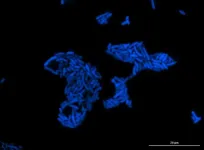INFORMATION:
Funding for this work was provided by gifts to the Brigham from Amos and Barbara Hostetter and the Chleck Family Foundation. Walt is an inventor of the Simoa technology, founder of the company and serves on its Board of Directors. Walt's interests were reviewed and are managed by Brigham and Women's Hospital and Mass General Brigham in accordance with their conflict of interest policies. The anti-SARS-CoV-2 Simoa assays in this publication have been licensed by Brigham and Women's Hospital to Quanterix Corporation.
Paper cited: Ogata A et al. "Circulating SARS-CoV-2 Vaccine Antigen Detected in the Plasma of mRNA-1273 Vaccine Recipients" Clinical Infectious Diseases DOI: 10.1093/cid/ciab465
Ultrasensitive blood test detects viral protein, confirms vaccine activates robust immune response
In series of samples collected from individuals vaccinated against COVID-19, an ultrasensitive test detected low concentrations of circulating antigen; Following robust production of antibodies, viral protein declined to undetectable levels
2021-05-26
(Press-News.org) The carefully orchestrated dance between the immune system and the viral proteins that induce immunity against COVID-19 may be more complex than previously thought. A new study by investigators at Brigham and Women's Hospital used an ultrasensitive, single-molecule array (Simoa) assay to detect extremely low levels of molecules in the blood and measured how these levels change over the days and weeks following vaccination. The team found evidence of circulating protein subunits of SARS-CoV-2, followed by evidence of the body mounting its immune response and then clearing the viral protein to below the level of single-molecule detection. Results are published in Clinical Infectious Diseases.
"Because of our ultra-sensitive method, we're able to corroborate that the mRNA vaccine is operating as intended, stoking the body's immune response," said co-corresponding author David Walt, PhD, a member of the faculty in the Department of Pathology at the Brigham. Walt is also a member of the Wyss Institute and is a Howard Hughes Medical Institute Professor. "We were able to detect extremely low levels of viral protein and see that as soon as the body begins generating antibodies, those levels declined to undetectable." Walt has a financial interest in Quanterix Corporation, the company that developed the ultra-sensitive digital immunoassay platform used in this work.
To conduct their study, Walt and colleagues measured levels of SARS-CoV-2 protein subunits in plasma samples collected from 13 participants who received two doses of the Moderna (mRNA-1273) vaccine. Specifically, the team measured levels of SARS-CoV-2 antigens Spike, S1, and Nucleocapsid. The team examined plasma collected at 10-13 timepoints between 1 and 29 days after the first injection and 1-28 days after the second injection. The average age of participants was 24 and the percentage of female participants was 46.
The team found that 11-of-13 participants had low levels of SARS-CoV-2 protein (S1 subunit) as early as one day post-vaccination. S1 subunit protein level peaked on average five days after the first injection. In all participants, the level of S1 protein declined and became undetectable by day 14. Spike protein was detected in 3-of-13 participants an average of 15 days after the first injection. After the second vaccine dose, no S1 or Spike was detectable.
The team collected corresponding antibody data and showed that the immune response began to mount after the viral proteins were produced. Increased antibody levels correlated with viral protein clearance from plasma.
The researchers note that the level of translated protein detected was extremely low and disappeared once antibodies were detected. All participants in the study were healthy volunteers who were vaccinated but not infected with SARS-CoV-2.
"The vaccine is designed to introduce mRNA into the body, which is then translated into the Spike protein. It is the Spike protein that can activate the immune system, which in turn creates antibodies to prevent future infections," said co-first author Alana Ogata, PhD, a postdoctoral fellow in the Walt lab. "We observed that antibodies that target Spike and S1 proteins are generated as early as 1-2 days after circulating S1 is detected, followed by the clearance of proteins. Additionally, we see that the second dose does not result in circulating protein but does provide an additional boost in antibody levels, as expected."
Researchers note that limitations of the current study include the small sample size and potential biases that result from enrolling healthy, young adults, which may not be representative of the general population. The research team plans to continue their plasma studies in other populations, including pregnant people and children, to further understand the dynamics between viral proteins and the immune response.
ELSE PRESS RELEASES FROM THIS DATE:
Novel sensor discovered that helps bacteria detect and respond to formaldehyde
2021-05-26
Bacteria called methylotrophs can use methane and methanol as fuel; in doing so, they produce large amounts of formaldehyde during growth, but until recently no one knew how they detected and responded to this toxic compound. Publishing on 26th May, 2021 in the Open Access journal PLOS Biology, Christopher Marx of the University of Idaho and colleagues describe their discovery of a novel formaldehyde sensor in the bacterium Methylorubrum extorquens, and other methylotrophs.
Some may remember the pungent smell of this toxic chemical from high school dissections of formaldehyde-preserved animals. From bacteria to humans, all organisms produce at least a little formaldehyde ...
Cleveland clinic researchers identify new drug target for treating aggressive prostate cancer
2021-05-26
May 26, 2021, CLEVELAND: According to new findings published in Science Translational Medicine, Cleveland Clinic researchers have identified a promising drug target for treating and preventing aggressive, drug-resistant prostate cancer.
The team, led by Nima Sharifi, M.D., of Cleveland Clinic's Lerner Research Institute, demonstrated that inhibiting the protein H6PD led to significantly reduced tumor sizes and improved survival among mouse models with drug-resistant prostate cancer. The H6PD levels also were elevated in biopsied patient tumors, suggesting the protein might be targeted ...
Identifying new, non-opioid based target for treating chronic pain
2021-05-26
Milwaukee, May 26, 2021 - A non-opioid based target has been found to alleviate chronic touch pain and spontaneous pain in mice. Researchers at the Medical College of Wisconsin (MCW) discovered that blocking transient receptor potential canonical 5 (TRPC5) activity reversed touch pain in mouse models of sickle cell disease, migraine, chemotherapy-related pain, and surgical pain.
TRPC5 is a protein that is expressed in both mouse and human neurons that send pain signals to the spinal cord. The findings were published in Science Translational Medicine. The senior and co-first authors of the manuscript, respectively, are MCW researchers ...
The path to more human-like robot object manipulation skills
2021-05-26
What if a robot could organize your closet or chop your vegetables? A sous chef in every home could someday be a reality.
Still, while advances in artificial intelligence and machine learning have made better robotics possible, there is still quite a wide gap between what humans and robots can do. Closing that gap will require overcoming a number of obstacles in robot manipulation, or the ability of robots to manipulate environments and adapt to changing stimuli.
Ph.D. candidate Jinda Cui and Jeff Trinkle, Professor and Chair of the Department of Computer Science and Engineering ...
Ultra-low doses of inhaled nanobodies effective against COVID-19 in hamsters
2021-05-26
PITTSBURGH, May 26, 2021 - In a paper published today in Science Advances, researchers from the University of Pittsburgh School of Medicine showed that inhalable nanobodies targeting the spike protein of the SARS-CoV-2 coronavirus can prevent and treat severe COVID-19 in hamsters. This is the first time the nanobodies--which are similar to monoclonal antibodies but smaller in size, more stable and cheaper to produce--were tested for inhalation treatment against coronavirus infections in a pre-clinical model.
The scientists showed that low doses of an aerosolized nanobody named Pittsburgh inhalable Nanobody-21 (PiN-21) protected hamsters from the dramatic weight loss ...
An inhalable nanobody-based treatment prevented and treated SARS-CoV-2 infections in hamsters
2021-05-26
An inhalable nanobody-based treatment may effectively prevent and treat SARS-CoV-2 infections when administered at ultra-low doses, according to a new study in Syrian hamsters. This novel therapy, Pittsburgh inhalable Nanobody 21 (PiN-21), could provide an affordable, needle-free alternative to monoclonal antibodies for treating early infections. Sham Nambulli and colleagues recently developed PiN-21, which uses single-domain antibody fragments that are cheaper to produce than monoclonal antibodies. However, until this study, the efficacy of PiN-21 had not been reported in living organisms. To advance the development of this treatment, Nambulli et al. administered a 0.6 milligram per kilogram ...
Salmon virus originally from the Atlantic, spread to wild Pacific salmon from farms: Study
2021-05-26
Piscine orthoreovirus (PRV) - which is associated with kidney and liver damage in Chinook salmon - is continually being transmitted between open-net salmon farms and wild juvenile Chinook salmon in British Columbia waters, according to a new genomics analysis published today in Science Advances.
The collaborative study from the University of British Columbia (UBC) and the Strategic Salmon Health Initiative (SSHI) -- a partnership between Fisheries and Oceans Canada (DFO), Genome BC and the Pacific Salmon Foundation -- traces the origins of PRV to Atlantic salmon farms in Norway and finds that the virus is now almost ubiquitous in salmon farms in B.C.
It also shows that wild Chinook salmon are more likely to be infected with ...
Targeting plasmacytoid dendritic cells can reduce cutaneous lupus symptoms
2021-05-26
Jodi Karnell and colleagues have developed a monoclonal antibody, VIB7734, that reduces symptom severity in people with cutaneous lupus by targeting and depleting plasmacytoid dendritic cells (pDC) in blood and skin. In two phase I clinical trials involving a total of 67 people with autoimmune diseases such as lupus, treatment with VIB7734 was as safe as a placebo and significantly reduced pDC frequencies, the researchers found. The antibody also reduced the activity of a group of key immune proteins called type 1 interferons in skin. Both pDCs and type 1 interferons are suspected ...
Good bacteria can temper chemotherapy side effects
2021-05-26
In the human gut, good bacteria make great neighbors.
A new Northwestern University study found that specific types of gut bacteria can protect other good bacteria from cancer treatments -- mitigating harmful, drug-induced changes to the gut microbiome. By metabolizing chemotherapy drugs, the protective bacteria could temper short- and long-term side effects of treatment.
Eventually, the research could potentially lead to new dietary supplements, probiotics or engineered therapeutics to help boost cancer patients' gut health. Because chemotherapy-related microbiome changes in children are ...
Study finds ongoing evolution in Tasmanian Devils' response to transmissible cancer
2021-05-26
MOSCOW, Idaho -- May 26, 2021 -- University of Idaho researchers partnered with other scientists from the United States and Australia to study the evolution of Tasmanian devils in response to a unique transmissible cancer.
The team found that historic and ongoing evolution are widespread across the devils' genome, but there is little overlap of genes between those two timescales. These findings, published in Proceedings of the Royal Society B, suggest that if transmissible cancers occurred historically in devils, they imposed natural selection on different sets of genes.
Tasmanian devils suffer from a transmissible cancer called devil facial tumor disease (DFTD). Unlike typical cancers, tumor cells from transmissible cancers are directly transferred from one individual ...
LAST 30 PRESS RELEASES:
Interaction of climate change and human activity and its impact on plant diversity in Qinghai-Tibet plateau
From addressing uncertainty to national strategy: an interpretation of Professor Lim Siong Guan’s views
Clinical trials on AI language model use in digestive healthcare
Scientists improve robotic visual–inertial trajectory localization accuracy using cross-modal interaction and selection techniques
Correlation between cancer cachexia and immune-related adverse events in HCC
Human adipose tissue: a new source for functional organoids
Metro lines double as freight highways during off-peak hours, Beijing study shows
Biomedical functions and applications of nanomaterials in tumor diagnosis and treatment: perspectives from ophthalmic oncology
3D imaging unveils how passivation improves perovskite solar cell performance
Enriching framework Al sites in 8-membered rings of Cu-SSZ-39 zeolite to enhance low-temperature ammonia selective catalytic reduction performance
AI-powered RNA drug development: a new frontier in therapeutics
Decoupling the HOR enhancement on PtRu: Dynamically matching interfacial water to reaction coordinates
Sulfur isn’t poisonous when it synergistically acts with phosphine in olefins hydroformylation
URI researchers uncover molecular mechanisms behind speciation in corals
Chitin based carbon aerogel offers a cleaner way to store thermal energy
Tracing hidden sources of nitrate pollution in rapidly changing rural urban landscapes
Viruses on plastic pollution may quietly accelerate the spread of antibiotic resistance
Three UH Rainbow Babies & Children’s faculty elected to prestigious American Pediatric Society
Tunnel resilience models unveiled to aid post-earthquake recovery
Satellite communication systems: the future of 5G/6G connectivity
Space computing power networks: a new frontier for satellite technologies
Experiments advance potential of protein that makes hydrogen sulfide as a therapeutic target for Alzheimer’s disease
Examining private equity’s role in fertility care
Current Molecular Pharmacology achieves a landmark: real-time CiteScore advances to 7.2
Skeletal muscle epigenetic clocks developed using postmortem tissue from an Asian population
Estimating unemployment rates with social media data
Climate policies can backfire by eroding “green” values, study finds
Too much screen time too soon? A*STAR study links infant screen exposure to brain changes and teen anxiety
Global psychiatry mourns Professor Dan Stein, visionary who transformed mental health science across Africa and beyond
KIST develops eco-friendly palladium recovery technology to safeguard resource security
[Press-News.org] Ultrasensitive blood test detects viral protein, confirms vaccine activates robust immune responseIn series of samples collected from individuals vaccinated against COVID-19, an ultrasensitive test detected low concentrations of circulating antigen; Following robust production of antibodies, viral protein declined to undetectable levels




